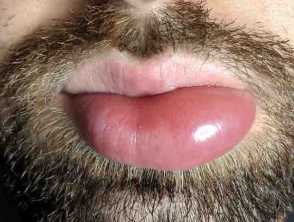What is ACE inhibitor-induced angioedema?
ACE inhibitor-induced angioedema is a rare but potentially fatal adverse effect of the class of medications that inhibit angiotensin converting enzyme (ACEi). It typically presents in the first weeks after starting the ACEi as swelling of the face, lips, or tongue in the absence of itch or urticaria.
Who gets ACE inhibitor-induced angioedema?
ACE inhibitors are very commonly prescribed medications used to treat hypertension, coronary artery disease, congestive heart failure, diabetic nephropathy, and chronic kidney disease. Angioedema is reported to affect 0.1–0.7% of those taking an ACEi, and is one of the most common causes worldwide of a patient presenting to an emergency department with angioedema.
Factors recognised to increase the risk of developing ACE inhibitor-induced angioedema include:
- African descent
- Age over 65 years
- Female
- Smoking
- Concurrent medications — aspirin and other non-steroidal anti-inflammatory drugs, calcium channel blockers, immunosuppressants sirolimus or everolimus prescribed for transplant recipients
- Past personal history of angioedema, ACEi-induced cough, drug rashes, seasonal allergies, asthma, chronic obstructive pulmonary disease, or rheumatoid arthritis.
What causes ACE inhibitor-induced angioedema?
ACE inhibitor-induced angioedema is due to the inhibition of bradykinin degradation resulting in elevated plasma bradykinin. As most people on ACEi are able to normalise the bradykinin level by other pathways, a genetic susceptibility is assumed. It is important to note ACE inhibitor-induced angioedema does not involve histamine.
What are the clinical features of ACE inhibitor-induced angioedema?
Angioedema is an acute, transient, localised deep swelling of skin or mucous membranes, typically affecting loose areas of tissue in non-dependent areas, and not usually associated with itch or urticaria.
ACE inhibitor-induced angioedema can involve:
- Oral mucosa and upper airways including swelling of the lips, tongue, and floor of mouth
- Symptoms may include dyspnoea, dysphagia, stridor, and hoarseness
- Swelling around the eyes is uncommon in ACE inhibitor-induced angioedema
- Gastrointestinal tract angioedema presenting with abdominal pain, anorexia, vomiting, diarrhoea, and/or ascites.
Episodes of angioedema usually begin in the first month after starting the ACEi, but onset can be delayed by months or years. Initially symptoms can be mild and self-resolving so identifying the cause may delayed.
How do clinical features vary in differing types of skin?
ACE inhibitor-induced angioedema particularly affects those of African descent.
Lip angioedema
What are the complications of ACE inhibitor-induced angioedema?
Swelling of the upper airways, including the tongue, can obstruct breathing resulting in asphyxiation and death.
Misdiagnosis of gastrointestinal angioedema may result in unnecessary laparotomy.
How is ACE inhibitor-induced angioedema diagnosed?
ACE inhibitor induced-angioedema is a clinical diagnosis based on typical episodes of angioedema in a patient taking an ACE inhibitor. A failure to respond to antihistamines, adrenaline (epinephrine), or systemic corticosteroids is a clue to diagnosis. Ceasing the drug should result in resolution of symptoms, although mild episodes may continue in the first few months.
Gastrointestinal angioedema may be diagnosed on ultrasound or CT scan.
What is the differential diagnosis for ACE inhibitor-induced angioedema?
ACE inhibitor-induced angioedema is a bradykinin-mediated angioedema, so must be distinguished from histamine-mediated angioedemas.
Other bradykinin-mediated angioedemas include:
- Hereditary angioedema
- Acquired deficiency of C1 esterase inhibitor (see Complement deficiencies).
What is the treatment for ACE inhibitor-induced angioedema?
General measures
General measures to treat ACE inhibitor-induced angioedema can include:
- Supportive care and monitoring
- Airway management, including tracheostomy or intubation
- Adrenaline, antihistamines, and steroids are unhelpful.
Specific measures
Specific measures to treat ACE inhibitor-induced angioedema can include the following.
- Cessation of the ACE inhibitor — no ACE inhibitor drug should ever be taken again. Angiotensin receptor-neprilysin inhibitor (ARNi) drugs are also contraindicated. Renin inhibitors and dipeptidyl peptidase-4 (DDP-4) inhibitors should be used with caution. The safest replacement for the ACEi would be an angiotensin receptor blocker (ARB).
- Treatments for hereditary angioedema have been tried — fresh frozen plasma, plasma-derived C1 inhibitor concentrate, tranexamic acid, ecallantide, and/or icatibant. However, strong evidence to support their use in ACE inhibitor-induced angioedema is lacking.
What is the outcome for ACE inhibitor-induced angioedema?
Mild episodes of ACE inhibitor-induced angioedema are self-limiting and resolve without treatment. However, episodes tend to become more frequent and more serious with continued use of the ACEi, and can be fatal if the cause is unrecognised. Discontinuing the ACEi is the only long-term management option, and episodes may continue in the weeks or months after cessation.
